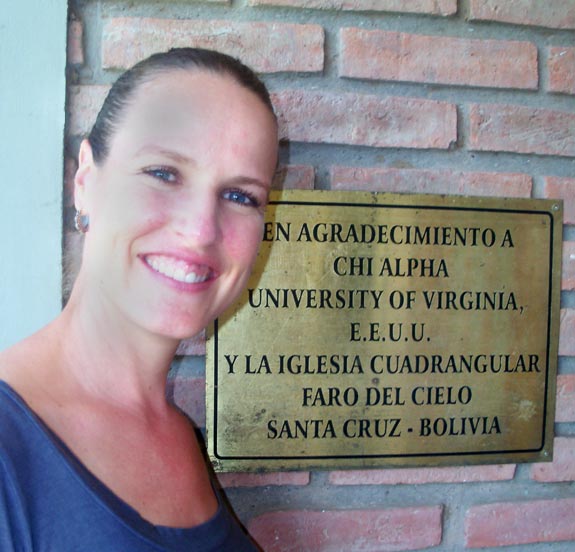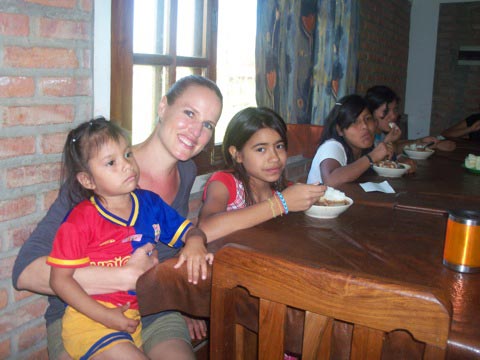A Summer at a Bolivian Orphanage
An alumna’s rejuvenating volunteer experience
Last summer, I visited an orphanage in Santa Cruz, Bolivia, called the Stansberry Children’s Home. The trip was full of unexpected coincidences and on the first day, I discovered surprising connections to both the University of Virginia and Canada, my country of birth.
Two years ago, I volunteered as a teacher and coordinator for an after-school Spanish club along with several parents in my Goochland community. Ms. Stansberry attended the club meetings with her two children. Her grandparents, Elena and John Stansberry, founded an orphanage in Bolivia in 1954. With this fortuitous connection, my sister Jennette and I applied to volunteer there.

We arrived in Santa Cruz in June 2011 and were chauffeured to our destination by ‘Tio Carlos’ or Uncle Chuck, one of the co-directors of the orphanage. As he drove us through the streets to our destination, close to the ‘quinto añillo’ or fifth ring of the city, we had our first dose of culture shock. The streets of Santa Cruz are littered with garbage, the buildings are cinder block, and the roads eventually transition from pavement to mud.
Santa Cruz is the largest city in Bolivia, an urban sprawl of 1.5 million, divided into seven “rings.” The orphanage is in the ‘Barrios de Missiones,’ a community of sprawling neighboring houses and businesses, two Evangelical churches and one Catholic Church. In addition to the voices of children, the orphanage is endlessly serenaded by sound from these churches. We were lulled to sleep or roused in the mornings by Catholic hymns or Evangelical drums and electric guitars amplified though loud speakers in these windowless cinder block structures.
In the first week, we learned the orphanage’s routines and structures. The Stansberry Children Home is divided into two parts, supported by churches and a board of directors in the United States and Canada. One part is the children’s home and orphanage and the other is the “The Guardaria Moises” or daycare.
When my sister and I met Tio Carlos and Tia Cindy, we instinctively recognized their Canadian accents. My sister and I are both Canadians by birth and still have family in Canada. Our first dinner in Bolivia was at Tio Carlos and Tia Cindy’s house. While I had expected to eat beans and rice for my first meal, we were instead served meatloaf and potatoes—a familiar Canadian dinner.
While touring the casas, we discovered the second coincidence. As I crossed the hearth of one of the “casas” where the children lived, I noticed a plaque bearing the name of Chi Alpha and the University of Virginia. I was told later that a team of students from Chi Alpha had contributed to the funding and building of the casas at the orphanage. Casa two bears the name “Katie,” the sister of the director of Chi Alpha, Pete Bullete. Katie tragically passed away from cancer, so casa two is named in her memory.

After settling in, we were given our job responsibilities. We babysat the little children, helped the older children bring their lunch from the central kitchen to their casas in a garden wheelbarrow, and served it out to the children at a large table. We made sure the children showered, dressed and combed their hair before going to school. In Bolivia, school-age children only attend school in the afternoons from 1 to 5 p.m.
Jennette assisted me with these duties, but she also spent several hours each morning and afternoons assisting workers at the ‘guardaria’ or daycare. While the Stansberry Children’s Home accommodates children from infancy all the way through their college years, the daycare is a community service for children who live outside the home. It was specifically added onto the orphanage several years ago with the intent of providing community outreach to single mothers and fathers in the community. The daycare also employs local Bolivians who care for the children during the day and provide them with basic education, hygiene and healthy food. The daycare is very important because it provides an extension of its much-needed services to children in the local community, who suffer from the effects of poverty and lack of education. The orphanage also offers a ‘biblioteca’ library program, a before- and after-school tutoring program for children who live in the orphanage and the surrounding community.
I spent my extra time working with the biblioteca’s educational psychologist and teaching English to the children of the biblioteca. I was invited by the school psychologist to help research and compile a presentation on Fetal Alcohol Syndrome. We presented our facts about Fetal Alcohol Syndrome and strategies that teachers and parents could use with who suffer from the syndrome.

I met beautiful children who will always have a special place in my heart. My sister and I held pizza parties for them. It was a big job to gather up ingredients from meager supplies and make pizza—from scratch—for more than 30 children. But to hear their prayers before the meal made the extra labor worth it. The children were always eager to pray and thank God for every blessing they could think of. Their pure and simple prayers revealed the voices of children who were blessed, loved and provided for. They also showed that the children longed for families and parents of their own.
I felt lucky to spend my summer at the children’s home. All the unexpected twists and turns of the journey seemed to lead right back home. And while I set out on the trip to help others, I found that I was the person who was helped the most.